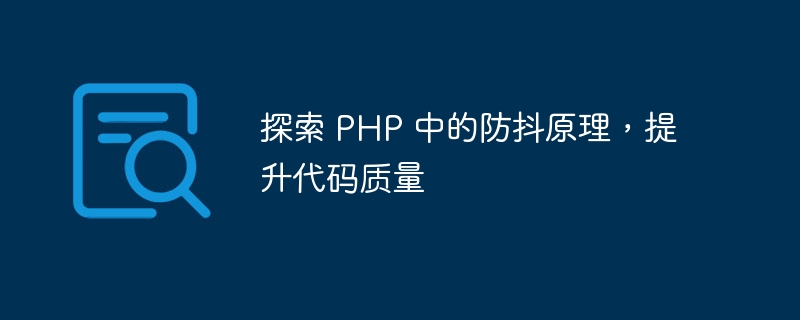Home >Backend Development >PHP Tutorial >Explore the anti-shake principle in PHP and improve code quality
Explore the anti-shake principle in PHP and improve code quality
- PHPzOriginal
- 2023-10-12 11:19:48976browse

To explore the anti-shake principle in PHP and improve code quality, specific code examples are needed
Debounce is a commonly used front-end technology that can prevent Excessive execution of corresponding actions when an event is triggered frequently. However, anti-shake is not only needed in front-end development, PHP back-end development can also learn from this principle to improve code quality.
The principle of anti-shake is to set a timer. Within the specified time interval, if events are triggered continuously, the timer will be cleared and the timing will be restarted. The corresponding execution will not be executed until no events are triggered within the specified time. operation. This can avoid frequently executing code in a short period of time and improve code execution efficiency.
The method of achieving anti-shake in PHP can be accomplished by using closures and timers. The following is a specific sample code:
function debounce(callable $callback, int $delay) {
$timerId = null;
return function() use ($callback, $delay, &$timerId) {
if ($timerId !== null) {
clearTimeout($timerId);
}
$timerId = setTimeout(function() use ($callback) {
$callback();
}, $delay);
};
}
function doSomething() {
// 执行相关操作
echo "执行操作" . PHP_EOL;
}
// 创建一个防抖函数,间隔时间为 1000ms
$debouncedFunc = debounce('doSomething', 1000);
// 模拟连续触发事件
for ($i = 0; $i < 10; $i++) {
$debouncedFunc();
usleep(200);
}In the above sample code, we created a debounce function that accepts a callable function and a delay time as parameters. The return value is a closure function, in which the anti-shake logic is processed.
When using the closure function, we maintain a variable $timerId to record the ID of the timer. Each time an event is triggered, if the timer already exists, the previous timer is cleared and timing starts again. Then, use the setTimeout function to set a timer that delays execution. When the delay time expires, the passed-in callback function is executed.
In actual applications, we can put the operations that need to be debounced in the doSomething function, and trigger these operations by calling the debounce function $debouncedFunc. By using the anti-shake function, even if multiple operations are triggered continuously, they will only be executed once after a certain time interval, thereby reducing unnecessary calculation and resource consumption.
To summarize, anti-shake technology can not only optimize the processing of frequent events on the front end, but can also be used for reference in PHP back-end development to improve code quality and execution efficiency. Combining closures and timers, we can easily implement the anti-shake function and demonstrate its working principle through specific function example codes. In actual projects, developers can flexibly use anti-shake technology to optimize code execution efficiency according to specific needs and scenarios.
The above is the detailed content of Explore the anti-shake principle in PHP and improve code quality. For more information, please follow other related articles on the PHP Chinese website!
Related articles
See more- Explore the PHP life cycle
- Explore PHP and PHPMAILER: How to implement subscription behavior statistics in emails?
- Explore PHP and PHPMAILER: How to track subscription links in emails?
- Explore the future development direction and trends of PHP encryption algorithms
- Server Optimization Tips: Exploring the Mysteries of PHP8's Underlying Development Principles

